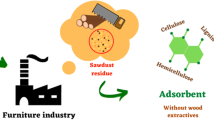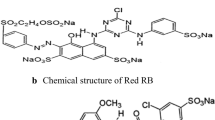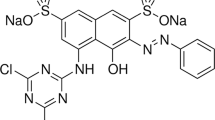Abstract
In this study, the applicability of char generated from poplar sawdust as an inexpensive adsorbent for the removal of a textile dye is investigated. Adsorbent samples were generated through pyrolysis at temperatures of 500, 600, 700 and 800 °C. The structural features of the char samples were illuminated by elemental analyses, FTIR, BET and SEM analyses. The effect of operating parameters such as initial dye concentration, pH and temperature were investigated and optimal values extracted. The adsorbent generated at 800 °C showed maximum adsorption efficiency of 83.4% at operating condition of pH 2, initial dye concentration of 50 ppm and temperature of 67 °C. We experimentally obtained equilibrium isotherms for the adsorption of the dye. The results were modeled using Langmuir, Freundlich and the Redlich–Peterson equations with corresponding parameters being determined. The mechanism was better represented by the Redlich–Peterson isotherm.







Similar content being viewed by others
References
(2012) Outline for national reports on activities related to poplar and willow cultivation exploitation and utilization. National Poplar Commission of Turkey
Acar FN, Eren Z (2006) Removal of Cu(II) ions by activated poplar sawdust (Samsun Clone) from aqueous solutions. J Hazard Mater 137(2):909–914
Açıkalın K, Karaca F, Bolat E (2012) Pyrolysis of pistachio shell: effects of pyrolysis conditions and analysis of products. Fuel 95:169–177
Ahmad AA, Hameed BH, Ahmad AL (2009) Removal of disperse dye from aqueous solution using waste-derived activated carbon: optimization study. J Hazard Mater 170(2):612–619
Aksu Z, Dönmez G (2003) A comparative study on the biosorption characteristics of some yeasts for Remazol Blue reactive dye. Chemosphere 50(8):1075–1083
Aksu Z, Tatlı Aİ, Tunç Ö (2008) A comparative adsorption/biosorption study of Acid Blue 161: effect of temperature on equilibrium and kinetic parameters. Chem Eng J 142(1):23–39
Alhashimi HA, Aktas CB (2017) Life cycle environmental and economic performance of biochar compared with activated carbon: a meta-analysis. Resour Conserv Recycl 118(Suppl C):13–26
Arami-Niya A, Daud WMAW, Mjalli FS (2011) Comparative study of the textural characteristics of oil palm shell activated carbon produced by chemical and physical activation for methane adsorption. Chem Eng Res Des 89(6):657–664
Ates F, Tezcan Un U (2013) Production of char from hornbeam sawdust and its performance evaluation in the dye removal. J Anal Appl Pyrol 103(Suppl C):159–166
Ates F, Un UT (2013) Production of char from hornbeam sawdust and its performance evaluation in the dye removal. J Anal Appl Pyrol 103:159–166
Ateş F, Pütün AE, Pütün E (2006) Pyrolysis of two different biomass samples in a fixed-bed reactor combined with two different catalysts. Fuel 85(12):1851–1859
Belhachemi M, Addoun F (2012) Adsorption of congo red onto activated carbons having different surface properties: studies of kinetics and adsorption equilibrium. Desalin Water Treat 37(1–3):122–129
Chan L, Cheung W, Allen S, McKay G (2012) Error analysis of adsorption isotherm models for acid dyes onto bamboo derived activated carbon. Chin J Chem Eng 20(3):535–542
Dawood S, Sen TK (2012) Removal of anionic dye Congo red from aqueous solution by raw pine and acid-treated pine cone powder as adsorbent: equilibrium, thermodynamic, kinetics, mechanism and process design. Water Res 46(6):1933–1946
Fan S, Tang J, Wang Y, Li H, Zhang H, Tang J, Wang Z, Li X (2016) Biochar prepared from co-pyrolysis of municipal sewage sludge and tea waste for the adsorption of methylene blue from aqueous solutions: kinetics, isotherm, thermodynamic and mechanism. J Mol Liq 220:432–441
Freundlich H (1906) Über die adsorption in Lösungen. Z Phys Chem 57(57):385–470
Frišták V, Micháleková-Richveisová B, Víglašová E, Ďuriška L, Galamboš M, Moreno-Jimenéz E, Pipíška M, Soja G (2017) Sorption separation of Eu and As from single-component systems by Fe-modified biochar: kinetic and equilibrium study. J Iran Chem Soc 14(3):521–530
Galhetas M, Mestre AS, Pinto ML, Gulyurtlu I, Lopes H, Carvalho AP (2014) Chars from gasification of coal and pine activated with K2CO3: acetaminophen and caffeine adsorption from aqueous solutions. J Colloid Interface Sci 433:94–103
Gan Q, Allen S, Matthews R (2004) Activation of waste MDF sawdust charcoal and its reactive dye adsorption characteristics. Waste Manag 24(8):841–848
Kaçan E, Kütahyalı C (2012) Adsorption of strontium from aqueous solution using activated carbon produced from textile sewage sludges. J Anal Appl Pyrol 97:149–157
Kim T-H, Park C, Shin E-B, Kim S (2004) Decolorization of disperse and reactive dye solutions using ferric chloride. Desalination 161(1):49–58
Koh J (2011) Dyeing with disperse dyes. Textile Dyeing, InTech
Kong L, Xiong Y, Tian S, Luo R, He C, Huang H (2013) Preparation and characterization of a hierarchical porous char from sewage sludge with superior adsorption capacity for toluene by a new two-step pore-fabricating process. Bioresour Technol 146:457–462
Langmuir I (1918) The adsorption of gases on plane surfaces of glass, mica and platinum. J Am Chem Soc 40(9):1361–1403
Lehmann J, Gaunt J, Rondon M (2006) Bio-char sequestration in terrestrial ecosystems—a review. Mitig Adapt Strat Glob Change 11(2):403–427
Leyva-Ramos R, Rivera-Utrilla J, Medellin-Castillo N, Sanchez-Polo M (2010) Kinetic modeling of fluoride adsorption from aqueous solution onto bone char. Chem Eng J 158(3):458–467
Liu Z, Zhang F-S, Wu J (2010) Characterization and application of chars produced from pinewood pyrolysis and hydrothermal treatment. Fuel 89(2):510–514
Lu G, Low J, Liu C, Lua A (1995) Surface area development of sewage sludge during pyrolysis. Fuel 74(3):344–348
Lucaci D, Duţă A (2009) Comparative adsorption of copper on oak, poplar and willow sawdust. Bull Transilv Univ Braşov 2:51
Martins AF, Cardoso ADL, Stahl JA, Diniz J (2007) Low temperature conversion of rice husks, eucalyptus sawdust and peach stones for the production of carbon-like adsorbent. Biores Technol 98(5):1095–1100
Medellin-Castillo N, Leyva-Ramos R, Padilla-Ortega E, Perez RO, Flores-Cano J, Berber-Mendoza M (2014) Adsorption capacity of bone char for removing fluoride from water solution. Role of hydroxyapatite content, adsorption mechanism and competing anions. J Ind Eng Chem 20(6):4014–4021
Mohan D, Sarswat A, Ok YS, Pittman CU (2014) Organic and inorganic contaminants removal from water with biochar, a renewable, low cost and sustainable adsorbent–a critical review. Bioresour Technol 160:191–202
Mui EL, Cheung W, Valix M, McKay G (2010) Dye adsorption onto char from bamboo. J Hazard Mater 177(1):1001–1005
Poinern GEJ, Senanayake G, Shah N, Thi-Le XN, Parkinson GM, Fawcett D (2011) Adsorption of the aurocyanide, complex on granular activated carbons derived from macadamia nut shells—a preliminary study. Miner Eng 24(15):1694–1702
Rajec P, Rosskopfová O, Galamboš M, Frišták V, Soja G, Dafnomili A, Noli F, Đukić A, Matović L (2016) Sorption and desorption of pertechnetate on biochar under static batch and dynamic conditions. J Radioanal Nucl Chem 310(1):253–261
Redlich O, Peterson DL (1959) A useful adsorption isotherm. J Phys Chem 63(6):1024
Šćiban M, Klašnja M (2003) Optimization of usage of wood sawdust as adsorbent of heavy metal ions from water. ISIRR 3:51–56
Singh KP, Mohan D, Sinha S, Tondon G, Gosh D (2003) Color removal from wastewater using low-cost activated carbon derived from agricultural waste material. Ind Eng Chem Res 42(9):1965–1976
Viglašová E, Daňo M, Galamboš M, Rosskopfová O, Rajec P, Novák I (2016) Column studies for the separation of 99mTc using activated carbon. J Radioanal Nucl Chem 307(1):591–597
Weng C-H, Lin Y-T, Tzeng T-W (2009) Removal of methylene blue from aqueous solution by adsorption onto pineapple leaf powder. J Hazard Mater 170(1):417–424
Wong Y, Szeto Y, Cheung W, McKay G (2004) Adsorption of acid dyes on chitosan—equilibrium isotherm analyses. Process Biochem 39(6):695–704
Yagub MT, Sen TK, Afroze S, Ang HM (2014) Dye and its removal from aqueous solution by adsorption: a review. Adv Coll Interface Sci 209:172–184
Yi S, Gao B, Sun Y, Wu J, Shi X, Wu B, Hu X (2016) Removal of levofloxacin from aqueous solution using rice-husk and wood-chip biochars. Chemosphere 150:694–701
Acknowledgements
The authors wish to thank all who assisted in conducting this work.
Author information
Authors and Affiliations
Corresponding author
Additional information
Editorial Responsibiility: Hari Pant.
Rights and permissions
About this article
Cite this article
Tezcan Un, U., Ates, F. Low-cost adsorbent prepared from poplar sawdust for removal of disperse orange 30 dye from aqueous solutions. Int. J. Environ. Sci. Technol. 16, 899–908 (2019). https://doi.org/10.1007/s13762-018-1716-9
Received:
Revised:
Accepted:
Published:
Issue Date:
DOI: https://doi.org/10.1007/s13762-018-1716-9




